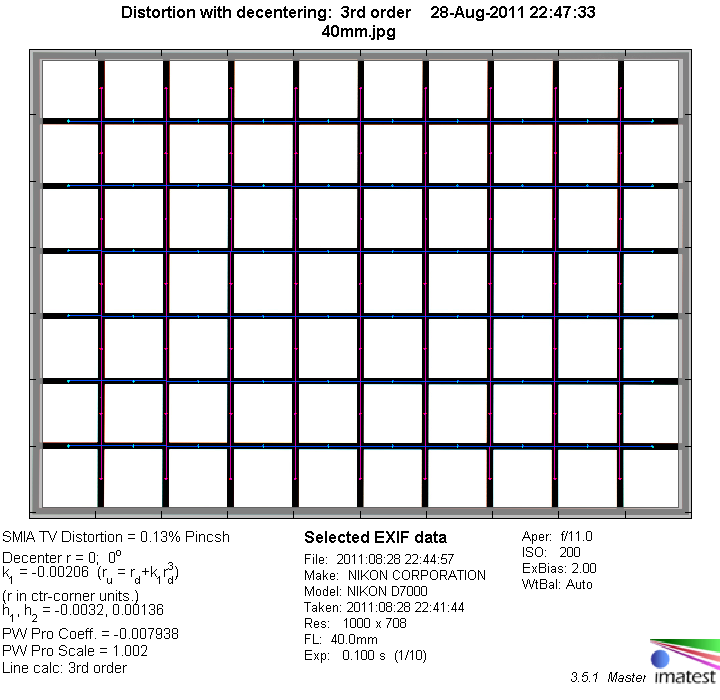|
Micro Nikkor AF-S DX 40mm f/2.8 G - Review / Test Report - Analysis |
|
Lens Reviews -
Nikon / Nikkor (APS-C)
|
|
Page 2 of 3

Distortion
There is a tiny degree of pincushion distortion, but it's such a small amount that it's practically irrelevant for almost any real-world image.

The chart above has a real-world size of about 120x80cm.
Vignetting
As you'd expect from a rather fast dedicated DX lens there is pronounced light fall-off towards the corners with wide open aperture. As usual, stopping down helps to reduce the issue significantly and from f/5.6 onwards vignetting is no longer relevant for most subjects.

MTF (resolution)
In the image center the lens delivers excellent sharpness wide open already. Stopping down increases the resolution even further, until diffraction begins to significantly reduce sharpness again from f/11 onwards.
The borders and corners show less resolution wide open, stopped down the sharpness increases to very good values and stays on a high level down to f/11.
Please note that the MTF results are not directly comparable across the different systems!
Below is a simplified summary of the formal findings. The chart shows line widths per picture height (LW/PH) which can be taken as a measure for sharpness.
If you want to know more about the MTF50 figures you may check out the corresponding Imatest Explanations

Chromatic Aberrations (CAs)
Chromatic aberrations (color shadows at harsh contrast transitions) are very moderate wide open, but slowly increase by stopping down. However, lateral CAs can easily be corrected in post processing and most newer Nikon DSLRs already do this on their own (as well as most of the current RAW converters).

Bokeh
The lens delivers very pleasing bokeh. In front of the focal plane the image blur is a bit rough, but in the more important area behind the focal plane the out of focus areas are rendered smoothly.
Background highlights are evenly filled and show no significant outlining at large apertures. The only issue here is some visible bokeh fringing around the borders (see next section).

Bokeh Fringing
Bokeh fringing is a common problem of most fast lenses. As you can notice below, the halos have different colors - magenta (red + blue) in front of the focus point and green beyond. Typical for most fast primes, the AF-S 40 shows some bokeh fringing at large aperture settings. Stopping down helps to reduce the amount of bokeh fringing significantly.
|
Move the mouse cursor over the f-stop marks below to observe the respective bokeh fringing
|
| f/2.8 |
f/4.0 |
f/5.6 |
f/8.0 |
|

|
|